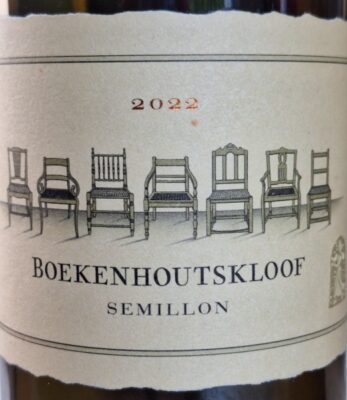Boekenhoutskloof Semillon 2022
By Christian Eedes, 20 March 2025

2

Fermentation occurred spontaneously, and the wine was matured for 14 months – 70% in new 225-litre barrels and 30% in a concrete egg.
The nose is currently restrained, with delicate notes of floral perfume, hay, citrus, white peach, fennel, and a whisper of vanilla appearing and receding. The palate is medium-bodied and well-balanced, offering expressive fruit, moderate acidity, and a subtle yet persistent savoury finish. Sleek and polished, it is creamy without being viscous or unctuous. Alc: 13.2%.
CE’s rating: 93/100.
Check out our South African wine ratings database.







Christian Eedes | 3 April 2025
Hi SJB, While I wouldn’t have used such pejorative terms as “creosote” or “diesel-like,” I do recall noticing pronounced reduction on the 2020 when I first tasted it.
SJB | 2 April 2025
This wine completely confounds me. I’ve bought a few bottles of it over the years based on the critical acclaim it receives (admittedly less so from winemag).
I recently opened the 2019 vintage and have previously drunk the 2020.
Upon opening the 2019 the first impression on the nose is an intense odour of what I can best describe as creosote. My dining partners took one sniff and sipped it gingerly and declared in revulsion that they couldn’t drink it. I soldiered on in what was more of an intellectual pursuit more so than enjoyment, wondering if the intense aroma would ‘blow off’ after time in the glass. I nursed it for a couple of hours and whilst the creosote odour diminished over time it remained by far the dominant characteristic of the wine and overpowered any enjoyment I might have gotten from the liquid alone. We surmised by the end of the evening that it was like drinking a glass of diesel.
I had a similar but less intense experience with the 2020 vintage with the same diesel-like notes but admittedly much less intense. The 2020 was at some level enjoyable and was duly finished. The 2019 got re-corked and remains in the fridge. I’ll venture another glass in a day or two but expectations are low.
I admittedly don’t drink a lot of semillon but have drunk enough to know that this is highly unusual. Could the bottle have been faulty (it was correctly stored)? If so then it’s a fault I’ve never encountered before despite drinking widely. And if it is a fault then why then does it occur in both the 2019 and 2020 vintages, albeit at different intensities? Was I just unlucky with those particular bottles? Reading through the tasting notes of various critics there is never a mention of anything that could be likened to the creosote-like aroma that I and my drinking partners experienced.